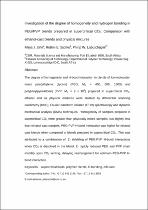 ResearchSpace
ResearchSpace
Investigation of the degree of homogeneity and hydrogen bonding in PEG/PVP blends prepared in supercritical CO2: comparison with ethanol-cast blends and physical mixtures
JavaScript is disabled for your browser. Some features of this site may not work without it.
- ResearchSpace
- →
- Research Publications/Outputs
- →
- Journal Articles
- →
- View Item
| dc.contributor.author |
Labuschagne, Philip W

|
|
| dc.contributor.author |
John, Maya J

|
|
| dc.contributor.author |
Sadiku, RE

|
|
| dc.date.accessioned | 2010-10-05T14:53:31Z | |
| dc.date.available | 2010-10-05T14:53:31Z | |
| dc.date.issued | 2010-07 | |
| dc.identifier.citation | Labuschagne, P.W., John, M.J. and Sadiku, R.E.. 2010. Investigation of the degree of homogeneity and hydrogen bonding in PEG/PVP blends prepared in supercritical CO2: comparison with ethanol-cast blends and physical mixtures. Journal of Supercritical Fluids, Vol. 54(1), pp 81-88 | en |
| dc.identifier.issn | 0896-8446 | |
| dc.identifier.uri | http://www.citeulike.org/user/Zuzina/article/6961087 | |
| dc.identifier.uri | http://hdl.handle.net/10204/4449 | |
| dc.description | Copyright: 2010 Elsevier. This is the author's pre print version of the work. The definitive version is published in the Journal of Supercritical Fluids, Vol. 54(1), pp 81-88 | en |
| dc.description.abstract | The degree of homogeneity and H-bond interaction in blends of low-molecular-mass poly(ethylene glycols) (PEG, Mw = 400, 600, 1000) and poly(vinylpyrrolidone) (PVP, Mw =9×103) prepared in supercritical CO2, ethanol and as physical mixtures were studied by differential scanning calorimetry (DSC), Fourier-transform infrared (FTIR) spectroscopy and dynamic mechanical analysis (DMA) techniques. Homogeneity of samples prepared in supercritical CO2 were greater than physically mixed samples, but slightly less than ethanol-cast samples. PEG–PVP H-bond interaction was higher for ethanol-cast blends when compared to blends prepared in supercritical CO2. This reduced interaction was attributed to a combination of: (1) shielding of PEG–PVP H-bond interactions when CO2 is dissolved in the blend; (2) rapidly reduced PEG and PVP chain mobility upon CO2 venting, delaying rearrangement for optimum PEG–PVP H-bond interaction. | en |
| dc.language.iso | en | en |
| dc.publisher | Elsevier | en |
| dc.relation.ispartofseries | Journal of Supercritical Fluids | en |
| dc.subject | Supercritical fluids | en |
| dc.subject | Polymer blends | en |
| dc.subject | H-bonding | en |
| dc.subject | Diffusion | en |
| dc.subject | Supercritical fluids | en |
| dc.title | Investigation of the degree of homogeneity and hydrogen bonding in PEG/PVP blends prepared in supercritical CO2: comparison with ethanol-cast blends and physical mixtures | en |
| dc.type | Article | en |
| dc.identifier.apacitation | Labuschagne, P. W., John, M. J., & Sadiku, R. (2010). Investigation of the degree of homogeneity and hydrogen bonding in PEG/PVP blends prepared in supercritical CO2: comparison with ethanol-cast blends and physical mixtures. http://hdl.handle.net/10204/4449 | en_ZA |
| dc.identifier.chicagocitation | Labuschagne, Philip W, Maya J John, and RE Sadiku "Investigation of the degree of homogeneity and hydrogen bonding in PEG/PVP blends prepared in supercritical CO2: comparison with ethanol-cast blends and physical mixtures." (2010) http://hdl.handle.net/10204/4449 | en_ZA |
| dc.identifier.vancouvercitation | Labuschagne PW, John MJ, Sadiku R. Investigation of the degree of homogeneity and hydrogen bonding in PEG/PVP blends prepared in supercritical CO2: comparison with ethanol-cast blends and physical mixtures. 2010; http://hdl.handle.net/10204/4449. | en_ZA |
| dc.identifier.ris | TY - Article AU - Labuschagne, Philip W AU - John, Maya J AU - Sadiku, RE AB - The degree of homogeneity and H-bond interaction in blends of low-molecular-mass poly(ethylene glycols) (PEG, Mw = 400, 600, 1000) and poly(vinylpyrrolidone) (PVP, Mw =9×103) prepared in supercritical CO2, ethanol and as physical mixtures were studied by differential scanning calorimetry (DSC), Fourier-transform infrared (FTIR) spectroscopy and dynamic mechanical analysis (DMA) techniques. Homogeneity of samples prepared in supercritical CO2 were greater than physically mixed samples, but slightly less than ethanol-cast samples. PEG–PVP H-bond interaction was higher for ethanol-cast blends when compared to blends prepared in supercritical CO2. This reduced interaction was attributed to a combination of: (1) shielding of PEG–PVP H-bond interactions when CO2 is dissolved in the blend; (2) rapidly reduced PEG and PVP chain mobility upon CO2 venting, delaying rearrangement for optimum PEG–PVP H-bond interaction. DA - 2010-07 DB - ResearchSpace DP - CSIR KW - Supercritical fluids KW - Polymer blends KW - H-bonding KW - Diffusion KW - Supercritical fluids LK - https://researchspace.csir.co.za PY - 2010 SM - 0896-8446 T1 - Investigation of the degree of homogeneity and hydrogen bonding in PEG/PVP blends prepared in supercritical CO2: comparison with ethanol-cast blends and physical mixtures TI - Investigation of the degree of homogeneity and hydrogen bonding in PEG/PVP blends prepared in supercritical CO2: comparison with ethanol-cast blends and physical mixtures UR - http://hdl.handle.net/10204/4449 ER - | en_ZA |





